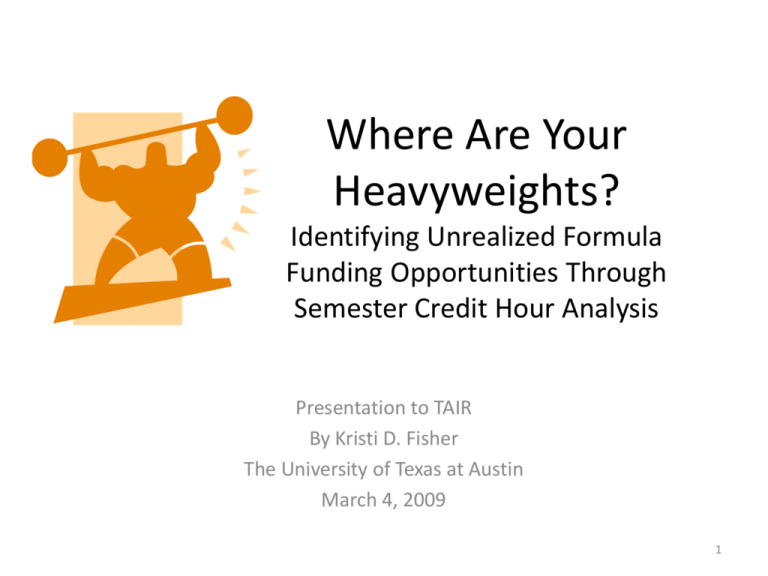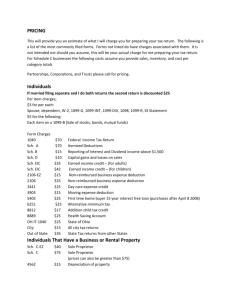Identifying Unrealized Formula Funding Opportunities through SCH
advertisement

Where Are Your Heavyweights? Identifying Unrealized Formula Funding Opportunities Through Semester Credit Hour Analysis Presentation to TAIR By Kristi D. Fisher The University of Texas at Austin March 4, 2009 1 Overview • • • • • What and why? David Prior’s work at TAMU – where to look Employing UT’s B.I. tools What the cube shows us Next steps 2 What and Why We are: • Analyzing student level, course level and discipline combinations by our institution relative to formula matrix weighting factors Because: • More funding mechanisms are being shifted to formulas • Understanding cost study and funding formulas key to maximizing state funding • In tough financial times we need to squeeze out every last drop… not just analyze the big-ticket items 3 Project Background • Project IQ Course Enrollments (CE) Cube Developed in 2005 Provided SCH by Discipline, etc. • David Prior’s (Texas A&M) Formula Funding Analysis • Created Tables to Hold “Rules” and “Weights” • Modified CE Cube to include Funding Area, Funding Level, Weighted SCH, and Formula Funding Amount • Prototyped for Executive Leadership in May 2008 • Presented completed cube in December 2008 4 David Prior’s Analysis: Formula Funding Factors • Factor One: Combinations of course/student levels producing SCH • Factor Two: Weight assigned to the resulting SCH level for the funding area • Factor Three: Tenure/Tenure-track teaching supplement – percent of UG SCH (***going away) 5 THECB Funding Level Rules Course Level Student Level Funding Level Lower Division All Levels Lower Division Upper Division Lower Classmen Lower Division Upper Division Upper Classmen & Above Upper Division Masters Lower Classmen Lower Division Masters Upper Classmen* Upper Division* Masters Post-Bac. & All Graduate Masters Doctoral Lower Classmen Lower Division Doctoral Upper Classmen Upper Division Doctoral Post-Bacc., Master, & Prof. Masters Doctoral Doctoral Doctoral * Exception: Seniors with more than 108 hours enrolled in masters-level course generate masters level funding. 6 THECB Weights Matrix (08-09) 7 Prior’s Key Data to Investigate • Number and $ of upper division students taking lower division courses • Number and $ of graduate students taking undergraduate courses • Number and $ of PhD students taking masters courses • Funding area weight relative to SCH production trends • Funding area WSCH and $ “difference” trends from year to year • Number WSCH and $ unrealized due to credit hour caps • Number WSCH and $ unrealized due to repeatability limits • Percent undergraduate SCH production taught by Tenured/Tenure-Track faculty 8 UT Rules Table 9 UT Weights Table 10 How Project IQ Works The products of IQ are “cubes” and reports. 11 Business Intelligence Tools • Transactional Systems: ADABAS/Natural • ETL tools: IBM Data Stage; Treehouse tRelational / DPS • RDBMS: Oracle 9i/10g, SQL-Server • O/S: Sun Solaris RAC, IBM Z/OS, Windows 2003 • BI tools: Cognos Powerplay 7.4, Impromptu 7.4, Cognos 8.2/8.3 (new) • Named User Accounts: 1,250 12 IQ Data Integrity Legacy Systems (original) Legacy Systems (revised) Four – way data validation: 1. Mainframe to Mainframe 2. Mainframe to Oracle 3. Oracle to Cubes 4. Cubes to Mainframe COGNOS ORACLE (warehouse) Course Cube Student Cube Faculty Cube Enrollment Report 13 Formula Funding Cube 14 Measures • • • • • • SCH Weighted SCH Enrollment (Seats Taken) Number Unique Sections Average End Class Grade Formula Funding Amount 15 Dimensions • • • • • • • • • • • Offering College / Department Year / Semester Funding Level Funding Area Funding Status Course Level Student Level Student Major College / Department Tenure Status Primary Instructor Rank Semester Group 16 Can Answer Questions Like… • What is the recent trend in weighted SCH production by (major/offering) College? • What is the trend in formula funding amounts generated by College? • How has the overall SCH production varied by funding area and level since 2005? 17 And… • How many SCH and $ are generated, by student level and course level? • What are the funding area WSCH and $ change trends from year to year • How many WSCH and $ were unrealized due to repeatability limits? • What percent of undergraduate SCH production was taught by Tenured/Tenure-Track faculty? 18 Disclaimers • Limitations: – – – – – Fiscal Year vs. Base Period Year 108 hour rule for seniors in masters courses Doctoral students over the 99 hour limit Some funding area mismatches w/ THECB area Data will not match SCH provided by THECB • Completed cube is 95% validated; not yet moved to production; not yet used campus-wide 19 DEMO 20 What is the recent trend in weighted SCH by college? 21 What is the trend in funding amount? 22 How has SCH by funding area and level changed? 23 How many SCH and $ are generated by student and course level? 24 What are the funding area WSCH and $ change trends from year to year? 25 How many WSCH and $ unrealized due to repeatability limits? 26 What percent of undergraduate SCH production was taught by TT faculty? 27 Initial Results 07-08 Pilot Data • $417k+ in lost funds due to excess hours • $468k+ in lost funds due to repeatability rules • Graduate students in undergraduate courses 28 Questions? Kristi D. Fisher University of Texas at Austin Office of Information Management and Analysis kfisher@austin.utexas.edu (512)471-3833 29




